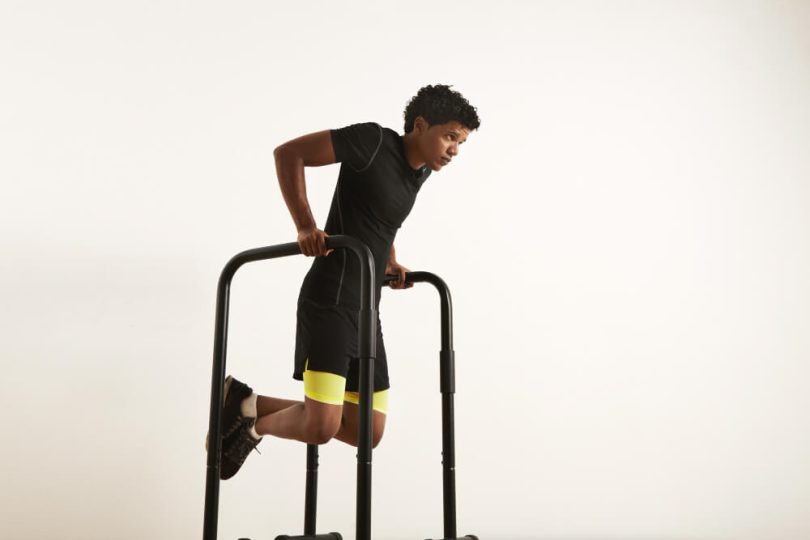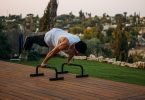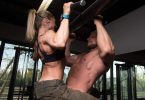Dips are a basic compound exercise that is one of the best (if not the best) for increasing total upper body mass and strength.
Preparation is key when working out at home because there are numerous ways to get the most bang for your buck while also minimizing the risk of getting hurt.
Because you’ll be putting almost all of your body weight on your shoulders, arms, and wrists during dips, it’s critical to make sure your grip isn’t too wide.
So, how wide should dip bars be apart?
The ideal width for freestanding dip bars is between 18 and 24 inches. You’ll have to consider what muscles you intend to target and your own body shape/size before making a decision.
Strengthening the triceps calls for a narrower grip closer to 18 inches; working the chest requires one that is wider by 24 inches.
The triceps, delts, lats, and traps get a good work out as well, making this one of the best pushing exercises for building upper body strength. The best part, however, is that you don’t need any special equipment to get started.
If you’re training at home, it can be even more difficult to figure out how to set the width and height of your dip bars because few people know how to do it correctly.
I’ll explain how to set up your dip bars in this article, as well as how to change it depending on the type of dip you’re making.
How Wide Should Dip Bars Be Apart
Dip bars should have a recommended width of 18-24 inches, but this should not be taken as a rule of thumb.
However, it’s important to note that this is only an average. The width at which you should perform dips varies from person to person because it is a bodyweight exercise. Because of this, when doing dips at home, it is important to know how wide your grip should be.
You’ll want to use your own body to judge the distance, which is as easy as it sounds.
As previously stated, wide dips can be beneficial to your workout if done correctly. When you spread your arms out, the position of your elbows serves as a guide for determining the maximum width of your grip. Please keep in mind that this is the widest dip you should ever attempt.
You’ll want to use a shoulder-width grip for triceps-targeting narrow grip dips, but don’t overdo it. There are times when a narrow grip dip is ideal, but there are times when it isn’t, and that’s why it’s important to keep your upper body upright.
You don’t want to overextend when doing wide grip dips, so a grip that is slightly wider than shoulder width is ideal. Leaning forward is the best way to focus on the chest. This shifts your weight and center of gravity forward, putting more emphasis on the chest.
Because you don’t want to overcomplicate things, only two widths of dip bars should ever be used, typically ranging from 18 to 24 inches (though this can be more or less depending on each individual).
My Dip Bars: How High Should They Be?
How tall you are will determine the answer to this question, just as how broad your shoulders determine how wide your dip grip should be. At any height between 3 and 6 feet, as long as you can extend yourself through the full range of motion you’ll be fine.
As you perform the exercise, keep in mind that proper form requires your legs to be bent at the knee, which should compensate for the distance you dip.
Wide Dips: Are They Good or Bad?
The short answer is that wide dips can be beneficial, but it all comes down to your training goals.
Many people believe that wide dips are bad for the shoulders, but this is simply not the case. When done correctly, wide dips are completely safe and actually target a different set of muscles than regular dips.
If you have any existing shoulder or mobility issues that could cause impingement and pain during the dip, wide grips should be avoided.
When performing dips, most people set the dip bars too far apart, which places a lot of stress on the shoulder joint rather than the chest and front delt muscles, resulting in a less effective workout.
When it comes to bodyweight exercises such as dips, proper technique is essential. In this case, it’s safe to say that wide dips have a bad reputation because of bad form.
Consider the following when incorporating wide dips into your upper-body or chest-training regimen:
- Push yourself back up once your upper arms are parallel to the floor. Anything beyond this range of motion will only cause unnecessary damage to your shoulders and your chest.
- The elbows should not be locked at the peak of the movement. While an Olympic gymnast may lock-out on the dip, it is not recommended for beginners to do so at home. Instead, keep the active muscles under tension.
Dipping alternatives you can use at home?
You don’t need any equipment to get a good workout with dips and other bodyweight exercises, so you can do them anywhere in your house. If you’re looking for inspiration, here are a few examples:
A simple set of dip bars can help you perfect your dips in the comfort of your own home because they’re small, light, and inexpensive. Some models can be used for raised push-ups and other exercises, but they aren’t as versatile as other options.
Power towers – these home gym titans – can really transform your bodyweight exercises into a full-blown workout. These towers are a solid investment, even if they aren’t as portable or budget-friendly. They have a wide range of grip positions for both narrow and wide dips.
Chairs, stairwells, and other household items can all be used as dip stations if you’re looking for the most cost-effective options. A dip can be done anywhere as long as you can put your weight on the surface and secure a safe grip.
In a nutshell:
In order to properly target your triceps and chest, you must ensure that the dip bars are set at the correct width. If you set them too wide, you risk straining your shoulder joint, which could lead to injury. Because of this, the width of your dip bars is an extremely important consideration.
What is the ideal width of dip bars?
18 to 24 inches is a good rule of thumb to follow before making any adjustments as you become an advanced lifter and learn the optimal width for your specific body shape and goals.
When building a home gym, free-standing dip bars are a better option than fixed dipping bars because they allow for greater flexibility as you progress in your workouts, making them a better choice.







